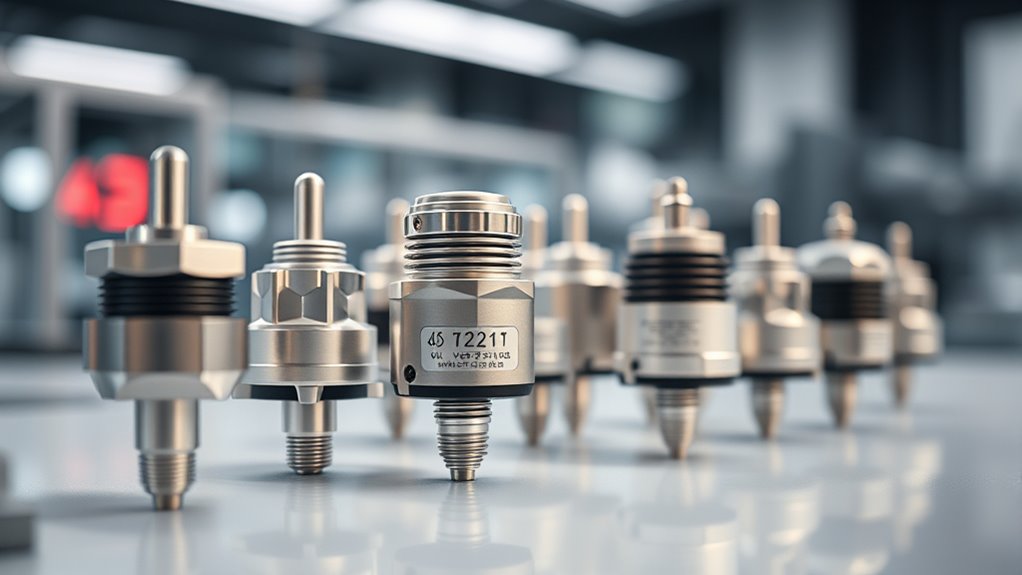When searching for the best vibration sensors of 2025, I’ve found several that stand out for their accuracy and reliability. Sensors like the YoLink LoRa and Aqara Vibration Sensor are perfect for smart home automation, while the WTVB01-BT50 offers advanced Bluetooth features. The THIRDREALITY Zigbee Sensor and various glass break alarms guarantee effective home security. Each model has unique strengths worth considering, and there’s much more to uncover to find the right fit for your needs.
Key Takeaways
- Look for vibration sensors with adjustable sensitivity settings to reduce false alarms and enhance reliability in various environments.
- Choose models with loud alarms (110dB to 130dB) for effective deterrence against intruders and immediate alerts.
- Consider battery-powered devices with long battery life (up to two years) and low battery indicators for hassle-free maintenance.
- Ensure easy installation with peel-and-stick designs or plug-and-play functionality for seamless integration into smart home systems.
- Evaluate application versatility to meet specific needs, such as security for windows, doors, and monitoring valuable equipment.
YoLink LoRa Smart Vibration Sensor
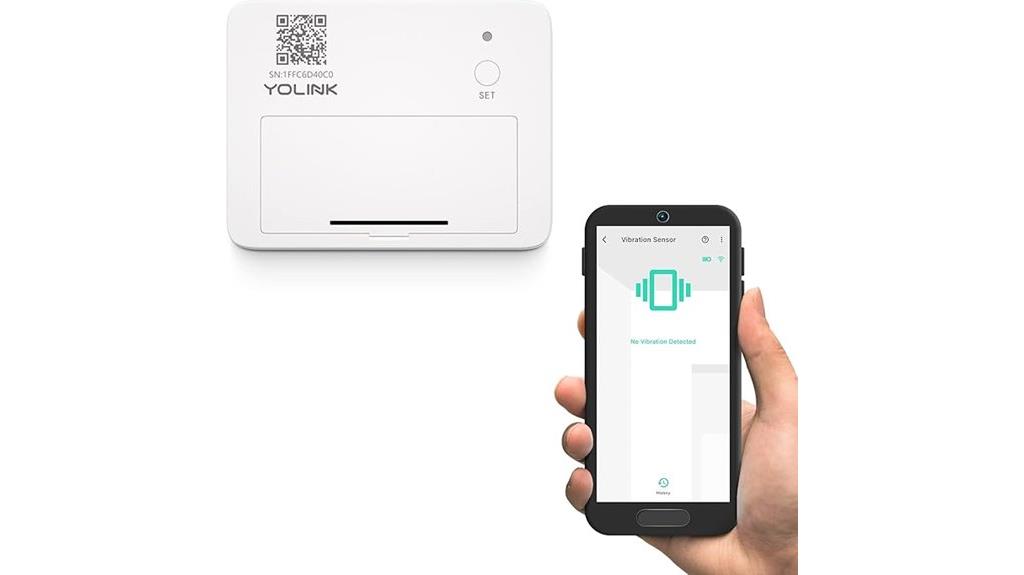
If you’re looking for a reliable way to monitor equipment or enhance security around your home, the YoLink LoRa Smart Vibration Sensor is an excellent choice. This device detects shock, glass breakage, and movement, sending alerts via email, SMS, or push notifications. With a range of up to a quarter mile, it easily penetrates obstacles. I love that it’s battery-powered and pairs with multiple devices without needing WiFi. It’s perfect for securing windows or monitoring appliances like generators. Plus, its customizable sensitivity settings allow me to tailor it to my needs, making it a fantastic addition to my smart home setup.
Best For: Homeowners and businesses looking for a versatile and reliable solution to monitor equipment and enhance security against theft and breakage.
Pros:
- Customizable sensitivity settings allow for tailored monitoring based on specific needs.
- Long-range capabilities provide superior penetration through obstacles compared to traditional WiFi devices.
- Battery-powered design and device-to-device pairing eliminate reliance on WiFi or AC power.
Cons:
- Limited integration with IFTTT may restrict automation options for some users.
- Requires a smartphone for setup and notifications, which may not be ideal for all users.
- Some users have suggested a need for additional features in alert management.
Aqara Vibration Sensor for Smart Home Automation

The Aqara Vibration Sensor stands out as an ideal choice for those seeking smart home automation solutions that prioritize security and ease of use. It requires an Aqara Hub and connects via Zigbee, ensuring reliable communication. I love that it detects unexpected vibrations, sending alerts directly to my phone. Plus, it can activate local alarms for added security. With an adjustable sensitivity level, I can fine-tune it for my needs. Installation is a breeze, too—no wiring required! While some reviews mention mixed sensitivity experiences, its quick integration with HomeKit makes it a solid addition for any smart home enthusiast.
Best For: Individuals looking for a reliable and easy-to-use smart home security solution that integrates seamlessly with Apple HomeKit.
Pros:
- Quick and easy installation with no wiring required.
- Adjustable sensitivity levels to cater to specific needs.
- Direct alerts to phone and local alarm activation for enhanced security.
Cons:
- Mixed reviews on sensitivity, with some users finding it less effective for subtle vibrations.
- May not meet all expectations for smart home automation applications.
- Adhesive strength could be too strong for lightweight usage, risking damage upon removal.
WTVB01-BT50 Smart Vibration Sensor Module
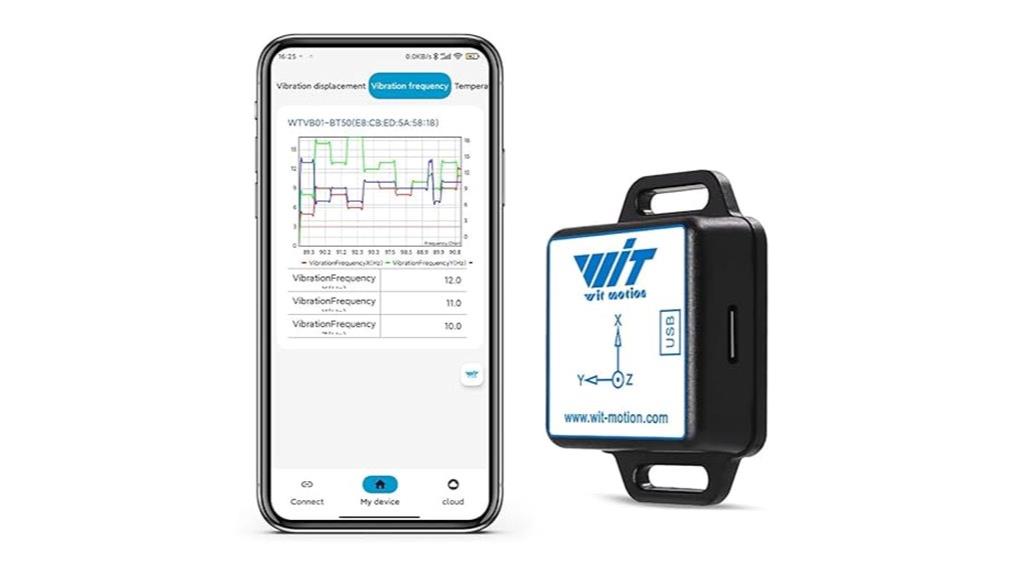
For those seeking precision in vibration monitoring, the WTVB01-BT50 Smart Vibration Sensor Module stands out with its advanced 3-axis vibration detection capabilities. It measures vibration displacement, speed, and amplitude, ensuring thorough monitoring. The wireless design simplifies installation on hard-to-reach areas, while Bluetooth 5.0 connectivity allows for easy data transfer to smartphones or computers. I appreciate the WITMOTION app for its data visualization, although some users mention glitches. While it’s affordable and effective for various applications, I believe improvements in software usability and measurement resolution would enhance the overall experience for both tech-savvy and novice users.
Best For: Professionals and hobbyists seeking an efficient and affordable solution for vibration monitoring in various applications.
Pros:
- Wireless design allows for easy installation on hard-to-reach machine parts.
- Bluetooth 5.0 connectivity enables seamless data transfer to smartphones and computers.
- User-friendly WITMOTION app offers data visualization in both tabular and graphical formats.
Cons:
- Some users experience glitches in the software, affecting usability and data playback.
- The device could benefit from higher resolution in speed measurements for professional use.
- Reports of defects, such as the inability to zero out angle measurements, may hinder functionality.
THIRDREALITY Zigbee Vibration Sensor

Equipped with a powerful 110dB siren alarm, the THIRDREALITY Zigbee Vibration Sensor stands out as a top choice for anyone seeking robust home security solutions. I love how it operates on just two AAA batteries, lasting about a year. Its ZigBee compatibility means it easily integrates with devices like Echo and SmartThings, enhancing my smart home setup. I appreciate the adjustable sensitivity levels, allowing me to fine-tune it for various uses, from monitoring doors to appliances. Though some users reported a slightly lower alarm volume, its reliable performance and quick setup make it a solid investment for indoor monitoring.
Best For: Those seeking a reliable and flexible indoor home security solution with smart integration options.
Pros:
- Easy Integration: Compatible with popular smart home devices like Echo and SmartThings.
- Adjustable Sensitivity: Four sensitivity levels allow customization for various monitoring needs.
- Long Battery Life: Operates on two AAA batteries with approximately one year of use.
Cons:
- Limited Volume: Some users report the alarm volume is lower than advertised (around 70dB).
- Indoor Use Only: Not suitable for outdoor environments; rated for temperatures between 0 – 40°C (32 – 104°F).
- Sensitivity Triggers: May occasionally trigger from nearby noises, such as barking dogs.
5Pcs SW-420 Vibration Sensor Module for Arduino
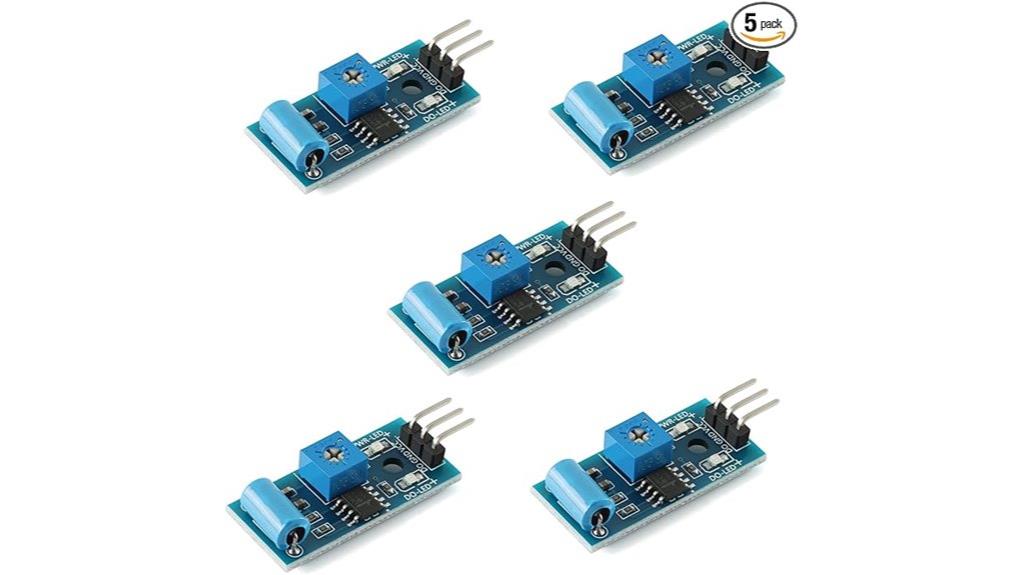
Designed specifically for makers and hobbyists, the SW-420 Vibration Sensor Module for Arduino stands out with its normally closed type operation, making it an ideal choice for projects that require reliable sensitivity to vibrations. It operates at a voltage range of 3.3V to 5V and features a compact PCB size of just 3.2cm x 1.4cm. The digital output signal is clean, and its driving ability exceeds 15mA, ensuring effective performance. With a built-in manual adjustment for sensitivity, it’s convenient to use with Dupont connectors. Garnering an impressive 4.6-star rating, it’s a must-have for any vibration sensing project!
Best For: Hobbyists and makers looking for a reliable and sensitive vibration sensor for their Arduino projects.
Pros:
- Compact size allows for easy integration into various projects.
- Manual sensitivity adjustment enhances versatility for different applications.
- Clean digital output ensures reliable performance with a driving capacity over 15mA.
Cons:
- Normally closed type may not suit all project requirements that need normally open sensors.
- Limited range of voltage (3.3V-5V) may restrict use with higher voltage systems.
- Requires additional setup and wiring with Dupont connectors, which may be challenging for beginners.
EVA LOGIK Modern Ultra-Thin Window Alarm (4 Pack)
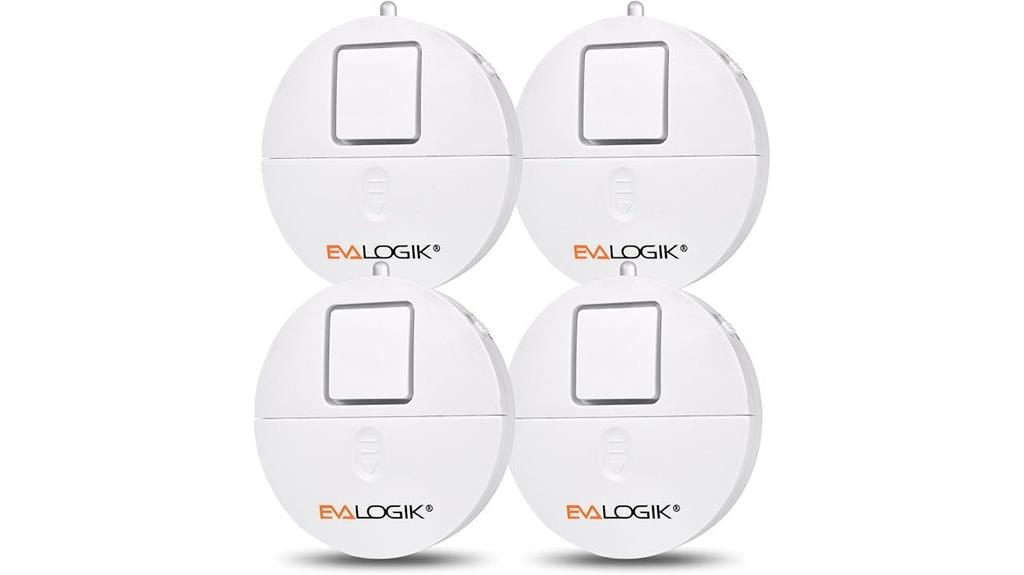
The EVA LOGIK Modern Ultra-Thin Window Alarm (4 Pack) is an excellent choice for anyone seeking a straightforward and effective home security solution. With its built-in vibration sensor, it activates a loud 120dB alarm that effectively deters intruders. I appreciate the customizable sensitivity settings, which help minimize false alarms. The installation is a breeze since it’s wire-free, and the visual alerts keep me informed about battery status. While some users experienced false alarms in sunlight, I find this budget-friendly alarm enhances my home’s safety. Overall, it’s reliable, easy to use, and a solid investment for peace of mind.
Best For: Individuals seeking a budget-friendly and easy-to-install home security solution that offers reliable intrusion deterrence.
Pros:
- Customizable sensitivity settings help reduce false alarms based on environmental factors.
- Wire-free installation allows for effortless setup and flexibility in placement.
- Loud 120dB alarm effectively alerts nearby individuals and deters potential intruders.
Cons:
- Some users may experience false alarms in direct sunlight, necessitating lower sensitivity settings.
- Adhesive stickers may not be visually appealing, leading some users to prefer a different display orientation.
- Battery longevity is still under evaluation, with mixed feedback on replacement frequency.
Aqara Vibration Sensor (Requires AQARA HUB)

If you’re looking for a reliable way to secure your valuables or monitor sensitive areas in your home, the Aqara Vibration Sensor is an excellent choice, especially if you already have an Aqara Hub. This battery-powered device connects via Zigbee and integrates seamlessly with Apple HomeKit and IFTTT. It detects unexpected vibrations, sending alerts directly to your phone or activating alarms. While its sensitivity is adjustable, some users find it struggles with subtle movements. Overall, it’s easy to install and has a two-year battery life, making it a practical option for enhancing your home security system.
Best For: Homeowners looking to enhance security for valuables or sensitive areas, particularly those already using an Aqara Hub.
Pros:
- Easy installation with no wiring required.
- Integrates seamlessly with Apple HomeKit and IFTTT for smart home automation.
- Long battery life of up to two years.
Cons:
- Mixed sensitivity results; may struggle with detecting subtle vibrations.
- Adhesive may be too strong for lighter units, making removal difficult.
- Less effective for general smart home automation compared to security applications.
GE Personal Security Wireless Glass Vibration Alarm
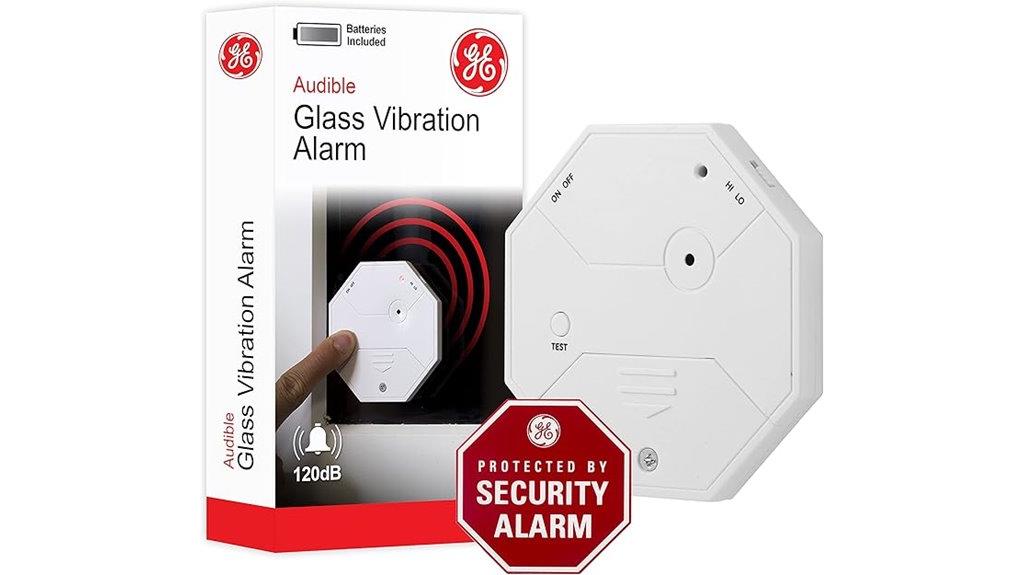
For anyone seeking a reliable home security solution, the GE Personal Security Wireless Glass Vibration Alarm stands out with its impressive 120-decibel alarm. I love how easy it is to install—just peel and stick, no wiring needed! With adjustable sensitivity settings, I can tailor it to my needs. It’s perfect for windows and sliding doors, giving me peace of mind at home. The loud alarm and visible warning sticker effectively deter intruders, making it a fantastic option for families, especially those with children. Plus, the included batteries guarantee I don’t have to worry about power outages.
Best For: Families, individuals, and caregivers seeking an easy-to-install, effective glass break and vibration alarm for enhanced home security.
Pros:
- Loud 120-decibel alarm effectively deters potential intruders.
- Easy peel-and-stick installation requires no wiring or tools.
- Adjustable sensitivity settings allow customization for different environments.
Cons:
- Limited to indoor use, which may not cover all security needs.
- Battery-operated, requiring periodic battery replacement.
- May not detect all glass breakage types, depending on sensitivity settings.
Window Alarm System 4-Pack with Vibration Sensors
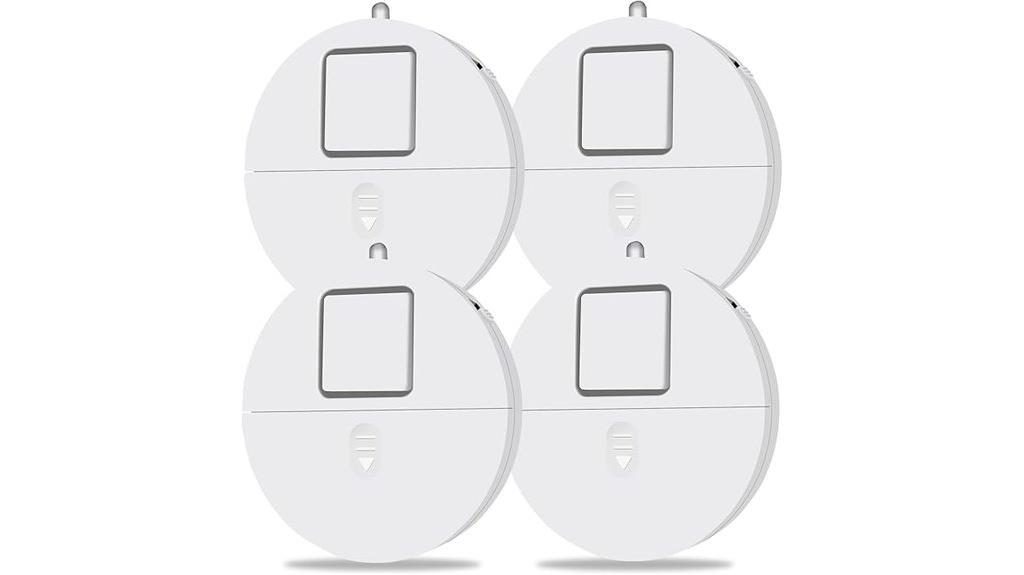
Ideal for homeowners seeking a reliable security solution, the Window Alarm System 4-Pack features advanced vibration sensors that minimize false alarms while delivering a piercing 120 dB sound when glass breakage is detected. I love how easy it is to install—just peel and stick! Plus, the red flashing LED serves as a great deterrent. Users have noted the alarms are impressively loud and effective, although some do experience occasional false alarms from pets or outside vibrations. With a low battery indicator, I always keep spare AAA batteries handy. This system is perfect for enhancing security in vulnerable areas.
Best For: Homeowners looking for an affordable and effective way to enhance security around vulnerable windows.
Pros:
- Easy installation with peel-and-stick application eliminates the need for tools.
- Loud 120 dB alarm effectively deters intruders and alerts homeowners to potential threats.
- Low battery indicator ensures users are aware of battery life, promoting reliability.
Cons:
- Occasional false alarms may occur due to pets or external vibrations, which can be disruptive.
- Requires AAA batteries that are not included, necessitating additional purchases.
- Limited to window use, which may not cover all security needs for a property.
CATSONIC Premium Window Alarm Device Set (6 Set Black)

Looking for a reliable way to secure your home or office? The CATSONIC Premium Window Alarm Device Set is an excellent choice with its extra loud 130dB alarm and advanced vibration sensors. Installation takes under a minute with no tools required—just peel and stick! It’s designed for any window, ensuring you get peace of mind. The mute switch lets you silence the alarm in standby mode, and the long-lasting batteries make maintenance hassle-free. While some users note sensitivity issues, the overall feedback is positive. It’s a budget-friendly option that enhances your security without breaking the bank.
Best For: Individuals seeking a budget-friendly and easy-to-install security solution for their home or office windows.
Pros:
- Easy installation: Set up in under a minute without the need for tools.
- Loud alarm: 130dB siren effectively alerts to potential intruders.
- Long-lasting batteries: Comes with pre-installed batteries that last 9-12 months.
Cons:
- Sensitivity issues: May trigger from minor vibrations, leading to false alarms.
- Not suitable for all windows: Designed specifically for glass windows, not doors or all sliding windows.
- Limited security coverage: Serves as a supplementary option rather than a comprehensive security system.
iHealth No-Touch Forehead Thermometer for Adults and Kids

The iHealth No-Touch Forehead Thermometer stands out with its non-contact technology, making it a top choice for parents monitoring their children’s temperatures. I love how it reads temperatures from just 1.18 inches away, ensuring safety and hygiene. The large LED display is easy to read, even in low light. With a gentle vibration signaling completion, it’s perfect for restless kids. While many users report quick and consistent readings, I’ve noticed some discrepancies during fever checks. Overall, it’s a great value for effortless temperature monitoring, but I recommend testing it under various conditions for the best results.
Best For: Parents looking for a safe, hygienic, and easy-to-use thermometer for monitoring their children’s temperatures.
Pros:
- Non-contact technology ensures safety and hygiene during use.
- Large LED display is easily readable, even in low-light conditions.
- Quick and consistent readings with gentle vibration feedback for completion.
Cons:
- Some users report discrepancies in accuracy, particularly during fever checks.
- Inconsistent readings noted by a portion of users compared to traditional thermometers.
- Recommendations for alternative thermometer types for more accurate fever detection.
HiLetgo Vibration Sensor Tilt Shaking Switches (100pcs)
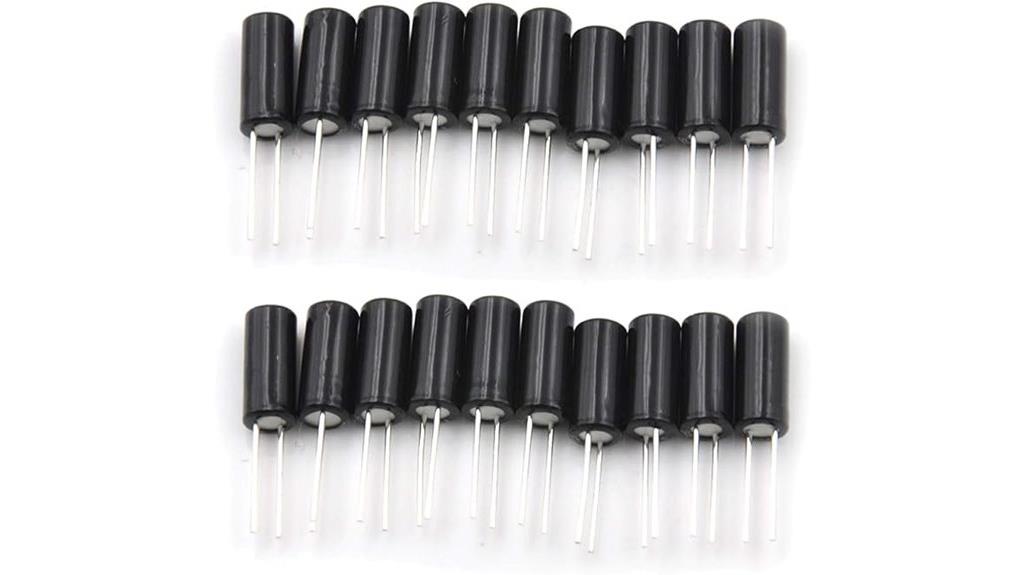
For those seeking a reliable and efficient solution for detecting vibrations, the HiLetgo Vibration Sensor Tilt Shaking Switches (100pcs) stand out with their robust design and impressive specifications. These SW-520D roll ball tilt switches operate automatically at a maximum voltage of 12V and current of 20mA. With an IP67 rating, they’re durable and suitable for various environments. I appreciate the normally open contact type, which guarantees precise operation. Each package includes 100 sensors, making it a great value. Just keep in mind that some users have reported soldering challenges due to plastic components. Overall, they’re a solid choice for vibration detection tasks.
Best For: Individuals and professionals looking for cost-effective and reliable vibration detection solutions in various applications.
Pros:
- Durable Design: With an IP67 rating, these sensors are suitable for use in different environments.
- Cost-Effective: Each package includes 100 sensors, providing great value for bulk purchases.
- Automatic Operation: The roll ball tilt switches operate automatically, ensuring efficient performance.
Cons:
- Soldering Challenges: Some users have reported difficulties with soldering due to plastic components.
- Limited Current Rating: The maximum current of 20mA may not be suitable for high-power applications.
- Variable Customer Feedback: Experiences among users vary, with mixed reviews on product reliability.
CARLOCK BT Vibration Sensor Add-on for Car Theft Protection

Car enthusiasts and security-conscious individuals will find the CARLOCK BT Vibration Sensor Add-on an essential tool for protecting their vehicles. This device enhances the CarLock system by providing instant motion detection and real-time security alerts. It effectively safeguards against theft, notifying you immediately if someone tampers with your doors or valuables. The installation is straightforward, thanks to its waterproof design and user-friendly setup. With a reliable one-year battery life and solid customer support, this add-on is a smart investment. While some users reported sensitivity issues, the overall performance and ease of use make it a top choice for vehicle security.
Best For: Car enthusiasts and security-conscious individuals looking to enhance their vehicle’s theft protection.
Pros:
- Easy installation with waterproof design and user-friendly setup.
- Provides instant motion detection and real-time alerts for tampering.
- Strong customer support with positive feedback on responsiveness.
Cons:
- Some users have reported sensitivity issues with the device.
- Connectivity challenges may arise for certain installations.
- Suggestions for multiple sensors indicate a need for better coverage in larger vehicles.
Wsdcam Glass Break Sensor Alarm for Home Security
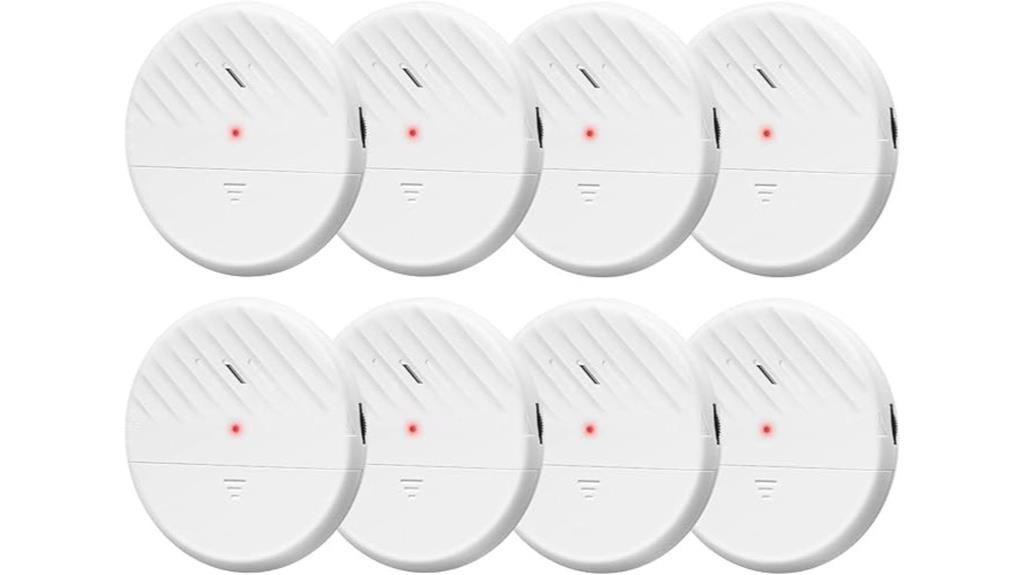
Looking for a reliable home security solution? The Wsdcam Glass Break Sensor Alarm might be just what you need. With a powerful 125dB alarm, this ultra-slim, wireless detector picks up on vibrations to deter potential intruders. I love how I can adjust the sensitivity to fit my home environment, reducing false alarms. The peel-and-stick installation is a breeze, and the battery lasts up to a year! Although some users mention occasional false triggers, I find its overall performance reassuring. If you’re looking to enhance your security discreetly, I highly recommend giving this sensor a try. It’s proven effective for many!
Best For: Those seeking a discreet and effective solution for enhancing home security against potential break-ins.
Pros:
- Easy peel-and-stick installation with no wiring required.
- Adjustable sensitivity to minimize false alarms based on the environment.
- Compact design that is less visible than traditional security cameras.
Cons:
- Some users report occasional false alarms triggered by loud noises or vibrations.
- Considered slightly expensive by some compared to similar products.
- High decibel level may be too loud for households with pets.
Glass Break Sensor 5 Pack for Home Security
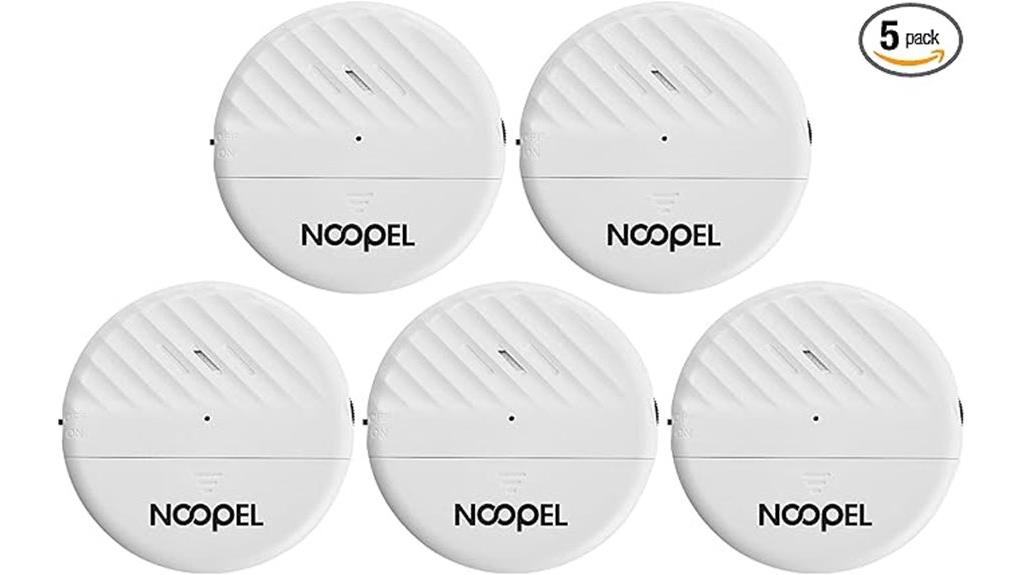
The Glass Break Sensor 5 Pack is an excellent choice for anyone seeking reliable home security solutions, especially those living in apartments or shared spaces. I love how it activates at the sound of breaking glass, ensuring I’m alerted with a loud 125dB alarm for 30 seconds. Installation is a breeze with the peel-and-stick design, and the adjustable sensitivity helps cut down false alarms. Each sensor runs on included LR44 batteries, and the low battery indicator is a nice touch. Overall, it’s a solid investment for protecting my home and providing peace of mind wherever I am.
Best For: Those living in apartments, offices, or shared spaces who want reliable protection against glass break-ins.
Pros:
- Loud 125dB alarm effectively alerts you to potential break-ins.
- Easy peel-and-stick installation requires no tools or wiring.
- Adjustable sensitivity settings help reduce false alarms.
Cons:
- Some users reported battery life issues with units failing after a few months.
- Limited to detecting glass breaking only; may not cover other security threats.
- Requires regular battery replacements, which can add to maintenance.
Factors to Consider When Choosing Vibration Sensors
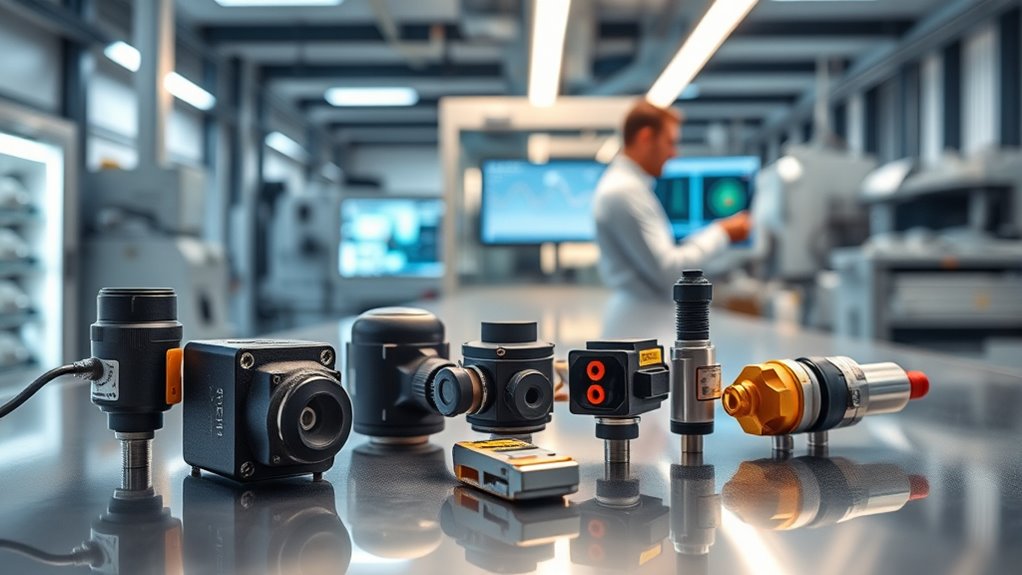
When selecting vibration sensors, I’ve found it essential to take into account several factors that can impact their effectiveness. Sensitivity adjustment options, power source type, and connectivity protocol compatibility all play a significant role in performance. Plus, the range, coverage area, and ease of installation can make a big difference in how well they meet our needs.
Sensitivity Adjustment Options
Choosing the right vibration sensor often hinges on the sensitivity adjustment options available. I’ve found that these options typically range from low to high levels, allowing you to customize the sensor’s response to various vibration intensities. Some models even offer a 21-step sensitivity range, which is fantastic for precisely determining what triggers an alert, consequently reducing false alarms. You can adjust sensitivity through physical switches or user-friendly software interfaces, making it easy to modify responsiveness as needed. High sensitivity settings are great for detecting subtle vibrations, while lower settings help avoid false alerts from everyday disturbances. Properly adjusting sensitivity enhances the sensor’s effectiveness in security applications, ensuring it responds to genuine threats while minimizing unnecessary notifications.
Power Source Type
While evaluating vibration sensors, one essential factor I consider is the type of power source they use. Battery-operated systems offer great flexibility for installation, allowing me to place sensors without worrying about wiring or outlets. However, battery life can vary; some models last up to two years, while others need more frequent changes. I’ve also found wired connections to provide continuous power, but they restrict placement options. Some sensors come with rechargeable batteries, which are convenient but require downtime for charging. Ultimately, the choice of power source affects portability, reliability, and maintenance. I always think about the specific application and environment to guarantee peak performance when selecting the right sensor for my needs.
Connectivity Protocol Compatibility
Understanding connectivity protocol compatibility is essential for maximizing the effectiveness of vibration sensors in my smart home setup. I’ve noticed that different protocols, like Zigbee, LoRa, and Bluetooth, all come with unique capabilities. Zigbee sensors often need a compatible hub but can integrate smoothly with platforms like Apple HomeKit and IFTTT for automation. On the other hand, LoRa technology is perfect for outdoor use, allowing long-range communication where WiFi isn’t available. However, Bluetooth sensors typically have a shorter range and may require direct pairing with my smartphone, which can be limiting in larger setups. By considering these factors, I can choose the right vibration sensor that fits seamlessly into my smart home ecosystem.
Range and Coverage Area
Range and coverage area are critical factors when I select vibration sensors for my smart home. I’ve noticed that the range dictates how far the sensor can effectively detect vibrations, with some outdoor sensors reaching up to 1/4 mile in open air. For indoor use, I typically look for sensors with a maximum range of around 15 meters. It’s important to evaluate how well a sensor can penetrate obstacles like walls or furniture; I prefer options using LoRa technology, as they perform better than traditional WiFi systems. Additionally, I appreciate adjustable sensitivity settings that allow me to customize detection ranges, helping to minimize false alarms. Ultimately, the intended application plays a key role in determining the right coverage area.
Installation Ease
Choosing vibration sensors with easy installation can make all the difference in setting up your smart home. I always look for options that feature adhesive mounting or peel-and-stick designs, as they eliminate the need for tools or complicated wiring. Plug-and-play functionality is another huge plus; it allows me to integrate sensors quickly into my existing system without hassle. I’ve noticed that user feedback often praises straightforward installation processes, which greatly boosts customer satisfaction and product ratings. Plus, I prefer sensors that are lightweight and compact, as they’re easier to place in various locations. Ultimately, minimal setup requirements mean I can deploy my security solutions faster, giving me peace of mind right away.
Alarm Volume Level
When it comes to vibration sensors, alarm volume level plays a crucial role in their effectiveness. I’ve noticed that these levels can vary markedly, typically ranging from 110 dB to 130 dB. A loud alarm, around 120 dB, is usually enough to alert anyone nearby and deter potential intruders in residential areas. It’s also worth considering the sensitivity settings that allow you to adjust the alarm volume, which helps minimize false alarms while keeping security measures intact. Additionally, some devices emit continuous alarms for about 30 seconds, giving you ample time to respond. Choosing a higher decibel level can effectively attract attention and enhance security, especially in high-risk areas. So, think carefully about this feature when selecting a vibration sensor.
Battery Life Duration
Battery life duration is one of the most important factors I consider when selecting vibration sensors. It directly impacts how often I need to replace batteries and manage maintenance. Many sensors boast battery life ranging from several months to over two years, depending on their power consumption and usage frequency. For instance, some sensors last up to 12 months with typical use, while others can achieve up to 24 months if they’re designed for low power consumption. I also pay attention to the type of battery used, as alkaline batteries differ greatly in longevity compared to lithium ones. A low battery indicator is a feature I find valuable, ensuring that I can replace batteries on time for uninterrupted monitoring.
Application Versatility
Application versatility is essential in selecting the right vibration sensors, especially since they serve a wide range of purposes. For instance, I can use sensors for security monitoring of windows and doors, detecting movement in valuable items, or monitoring equipment like HVAC systems. The YoLink LoRa Smart Vibration Sensor excels for long-range applications, operating over a 1/4 mile in open-air conditions. Meanwhile, the Aqara Vibration Sensor triggers alerts for unexpected vibrations, fitting both security and automation needs. Some sensors, like the WTVB01-BT50, provide detailed measurements, making them perfect for industrial applications. Plus, adjustable sensitivity settings help customize performance based on environmental factors, enhancing effectiveness and minimizing false alarms. Choosing wisely guarantees I get the best performance for my specific needs.
Frequently Asked Questions
How Do I Install a Vibration Sensor Properly?
Installing a vibration sensor properly is essential for accurate readings. First, I make certain the surface is clean and free of debris. Then, I choose a flat, stable area for mounting. I use appropriate screws or adhesive to secure the sensor firmly. Next, I connect the sensor to the data acquisition system, guaranteeing the wiring is neat and secure. Finally, I calibrate it according to the manufacturer’s instructions to secure ideal performance.
What Is the Average Lifespan of Vibration Sensors?
I’ve found that the average lifespan of vibration sensors typically ranges from 5 to 15 years, depending on their quality and operating conditions. Factors like environmental conditions, exposure to harsh elements, and how well they’re maintained can greatly impact their longevity. Regular checks and proper installation can help maximize their lifespan. If you’re considering a purchase, I’d recommend looking for models with good reviews for durability and reliability.
Can Vibration Sensors Be Used Outdoors?
Imagine a watchful guardian, standing tall against the elements. That’s how I see vibration sensors outdoors. Yes, they can absolutely be used outside! They’re often built to withstand harsh conditions, like rain, dust, and temperature fluctuations. I’ve seen them monitor machinery in factories and even bridges. Just make certain you choose one specifically designed for outdoor use, as it’ll offer enhanced protection and guarantee reliable performance in the great outdoors.
How Do Vibration Sensors Communicate With Other Devices?
I’ve found that vibration sensors typically communicate with other devices through wired or wireless connections. Most commonly, they use protocols like Bluetooth, Wi-Fi, or even cellular networks to transmit data. This communication allows me to monitor vibrations in real-time and integrate them with my existing systems. By linking these sensors to a central hub or cloud service, I can analyze the data and make informed decisions about equipment maintenance or safety.
Are There Any Maintenance Requirements for Vibration Sensors?
Think of vibration sensors like delicate flowers in a garden; they need care to thrive. Yes, there are maintenance requirements for these sensors. I’ve found that regular calibration and cleaning are vital to keep them accurate. It’s also wise to check for loose connections and make certain they’re shielded from extreme conditions. By giving them a little attention, I’ve seen my sensors perform at their best, providing reliable data when I need it most.
Conclusion
In the world of vibration sensors, finding the right fit is like searching for a needle in a haystack. Each option offers unique strengths, whether it’s home security or smart automation. As you weigh your choices, remember that the best sensor isn’t just a tool; it’s a guardian, quietly watching over what matters most. Embrace the technology that resonates with your needs, and let it be the silent sentinel that keeps your world secure and connected.
